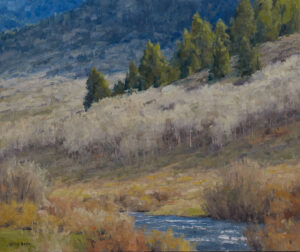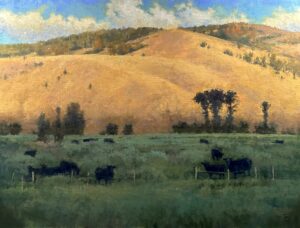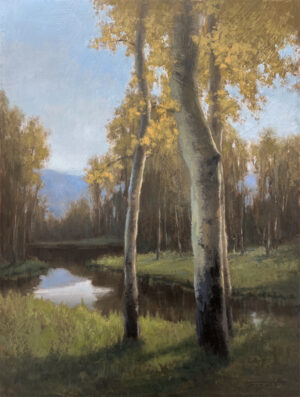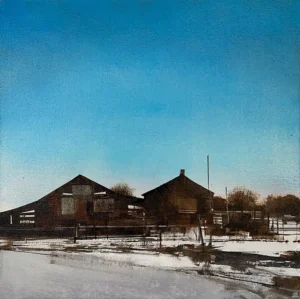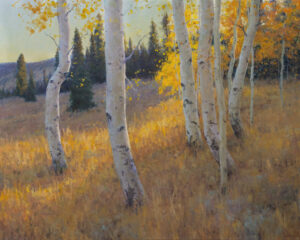Landscape Painting
The following video is by Shanna Kunz, a renowned landscape artist. In this video Shanna shares her interpretation of landscape painting and a look into her process.
Video Transcript ^
My paintings are representative of very personal places that have developed from lifelong familiar landscapes, memories of places and events that have shaped my view of the natural world. I like to think that they are a mix of Tonalism and Impressionism painted with a contemporary presence. I am always searching for the complexities of place, mood, and authenticity.
This painting is called Mountain Quietude, a large piece for me. It is an intimate composition of a crisp, autumn day with evidence of the first snow of the season and the thick, heavy atmosphere enveloping the pines and distant mountains. My hope is that one can feel the chill in the air, see their breathe as it leaves them. The river winds its way through the meadow sage and field grasses while nourishing the surrounding elements.
My work is not about details or things, it is about the mood – the simpler the better as it evokes a primal response that most can relate to and add their own story. Only when we relate to the landscape, do we take special steps to honor and protect it for future generations to come.
Landscape painters make their mark in the art world by capturing in paint the beauty and diversity of their surroundings expressed through a unique interpretation and personal experience.

Throughout time
From the early pioneers of landscape painting in the 19th century to the contemporary artists working today, American landscape painters have explored and celebrated the vast and varied landscapes of the United States. This work is generally identified into a variety of ism’s – Realism, Impressionism, Tonalism, Romanticism and Expressionism.
Landscape painting has evolved over time, with different artists and movements bringing their own unique styles and interpretations to the genre. From the romantic landscapes of the 19th century to the modern abstract interpretations of the 20th century, landscape painting continues to be a diverse and vibrant form of artistic expression.
Imagine our museums without the glorious impressionist work of Claude Monet depicting in series the portrayal of light and shadow in all of it’s glory, seen at every time of day and exploring color palettes in a manner that no one had thought of previously.
Image an art world without the quiet, peaceful but dynamic work of George Inness and his emotion-filled renditions of Montclair, the contemporary and lyrical brushwork of John Henry Twachtman, and the Luminous landscapes of Martin Johnson Heade, Thomas Cole and the Hudson River Valley painters.
This genre and its stable of artists’ masterpieces fill a necessity for the human experience of our natural world!
Albert Bierstadt was another prominent American landscape painter known for his majestic depictions of the American West. His paintings captured the awe-inspiring landscapes of the Rocky Mountains and Yosemite Valley with a sense of grandeur and drama for those that had never traveled West before.
Frederic Edwin Church, a student of Thomas Cole, was renowned for his detailed and luminous landscapes. His paintings showcased his mastery of light and color, as well as his ability to convey a sense of awe and wonder in the face of nature’s beauty.
In the 20th and 21st centuries, American landscape painters continued to explore and redefine the genre as they do now. Artists like Maynard Dixon with his billowing simplified clouds, Georgia O’Keeffe, known for her abstracted landscapes of the Southwest, and Ansel Adams, famous for his black-and-white photographs of the American West, brought a fresh visual perspective to the representation of the American landscape.
Last but certainly not least, Contemporary American landscape painters such as Wolf Kahn, Richard Diebenkorn, and Ed Mell, have continued to push the boundaries of the landscape, experimenting with new styles and techniques to capture the ever-changing lands of America.
Modern day, seasoned landscape artists have become adept at painting on location en plein air to gather color notes, composition, details and other information and take that knowledge back to the studio along with thumbnails, smaller studies and photography to complete a more considered and intentional larger piece.
The landscape paintings of this generation are a reflection of our ever-evolving world, capturing the beauty and complexity of nature in new and exciting ways. Artists are pushing boundaries, experimenting with different styles old and new, and incorporating modern elements into their work to create captivating and thought-provoking pieces of art.
As we watch the world technologically shift the possibilities of visual imagery, it will be fascinating to see how landscape paintings further evolve in the future.
A Few Landscape Examples at Illume Gallery West
Visit
130 East Broadway Street
Philipsburg, Montana 59858
Phone
Follow



